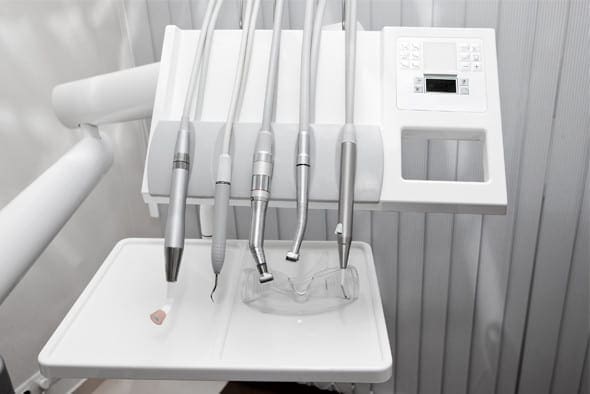No products in the cart.
Krytox™ Lubricant Articles
Krytox™ GPL-105 | Reduces Dental Handpiece Wear and Chatter
Krytox™ GPL-105 Handpiece oil | Reduces Dental Handpiece Wear and Chatter
Dental equipment and supply manufacture finds an H1 lubricant to reduce dental drill turbine maintenance and save money
A manufacturer of high-end dental equipment and supplies wanted to utilize high performance, H1 lubricant for the inside of their dental handpieces to reduce maintenance costs associated with turbine exchange and costly handpiece downtime. Turbine exchange and repair are usually due to heavy oxidation, debris or rust inside the handpiece that is caused by allowing autoclave steam vapor to stay contained inside the handpiece and over time leads to performance issues or failure. The H1 lubricant also had to withstand the high heat of a forced-air autoclave vs steam autoclave that is notoriously known to cause oxidation and premature wear inside a dental handpiece.
Steam Sterilization
Steam sterilization is the most common form of sterilization technique for dental practices and involves exposing dental instruments to 275°F, high pressurized, saturated steam. The high pressure and hot steam in combination enhance the ability to kill microorganisms by reducing the temperature and time required to breakdown proteins in the microorganisms. However, this steam and pressure combination causes severe substrate oxidation within a dental handpiece and over time leading to very costly repairs and downtime. Handpiece oxidation is caused by allowing steam vapor to stay contained inside the handpiece and over time this can lead to equipment performance issues or failure. The disadvantages of steam sterilizers can be found below.
- Cannot use closed instrument pouches
- Rusting/dulling of carbon steel items
- Hard Water Spotting on instruments
- The need for pre-drying instrument packages
- Wrapping & packaging must allow penetration of steam and movement of air outward.
Handpiece oil | Forced Air/ Dry-Heat Autoclave Advantages
The advantages of dry heat sterilization include minimal to no instrument rusting/dulling of carbon steel items that are dry at the end of the sterilization cycle. Dry heat sterilization involves the heating of air and then transferring heat energy to the dental instruments. This sterilization process requires temperatures higher than steam or unsaturated chemical vapor sterilizers. Operational temperatures vary from 160°C to 190°C (320°F to 375°F). The two types of dry heat are convection oven type sterilizers (static air) and rapid heat transfer (forced air). Forced-air or rapid heat transfer models circulate heated air throughout the unit. The result is a faster warm-up and shorter, but hotter operational cycles (e.g., 12 minutes at 190°C [375°F]).
Static air types usually require higher operational temperatures and longer cycles but are less expensive than forced air models. For example, static air types require one- to two-hour cycles at 160°C (320°F). Heat-up time maybe 15 to 30 minutes from a cold start. Additional benefits of Forced Air and Dry-Heat Autoclave techniques can be found below.
- Minimal to No Rust/Dulling of instruments
- Instrument sterilization pouches dry quickly after completion of a cycle
- No need for special sterilization chemicals
Krytox™ GPL-105 Handpiece oil solution
One of the greatest advantages of using Krytox GPL-105 oil is stability in a wide variety of operating conditions and environments. This inert nature is what allows Krytox oils and greases to outlast and outperform mineral oil-based dental products. Standard Krytox lubricants contain only carbon, oxygen, and fluorine; whereas, hydrocarbons contain hydrogen. The absence of hydrogen in this fluorine rich infused lubricant greatly increases the stability of the lubricant and renders them non-flammable with no flashpoint. They will not burn or support combustion, even in an environment of 100% liquid or gaseous oxygen. Krytox GPL-105 Oil is not only resistant to oxygen, but they are also inert to virtually all chemicals used in a variety of industries. They are insoluble in most solvents but are soluble in highly fluorinated fluids and some supercritical fluids, such as CO2. At elevated temperatures and pressures, PFPE oils are highly resistant to attack by gaseous and liquid oxygen. As a result, Krytox oils and greases have become preferred lubricants in the dental industry.
Utilization of our Krytox GPL-105 oil includes the following benefits:
- H1 Lubricant
- Non-Flammable
- Non-Nutrient
- Facilitates Smooth, Consistent, and Reliable Operations
Click here for more information about Krytox GPL Lubrication Series
Click here for Technical Support
Related Article Links
Krytox™ H-1 Food Grade Lubricants
Notwithstanding any express or implied indication to the contrary, product information provided on or via this website is supplied upon the condition that the persons receiving such information will make their own, independent determination as to a given product’s suitability for any contemplated purposes prior to use. In no event will Miller-Stephenson be responsible for damages of any nature whatsoever resulting from the use of, or reliance upon, information provided, directly or indirectly, on this website in relation to any product and/or application.

